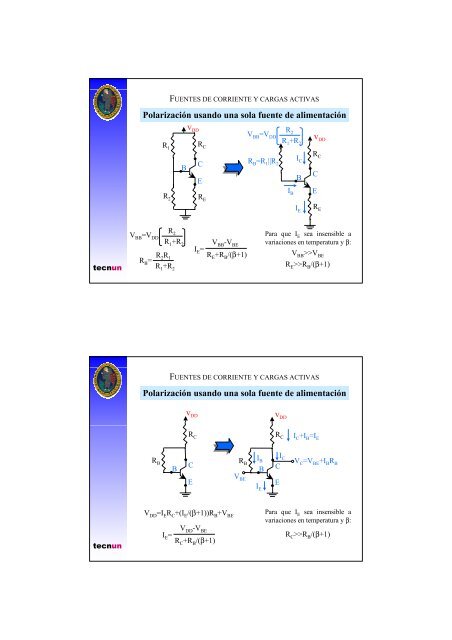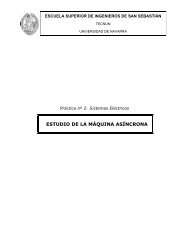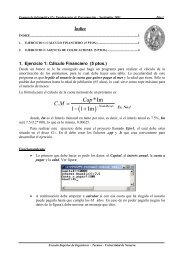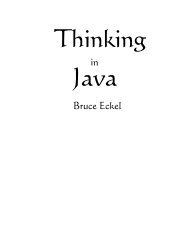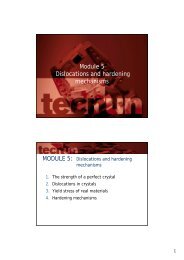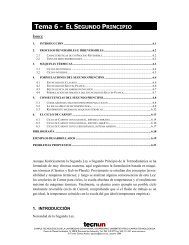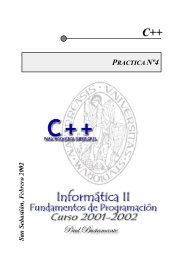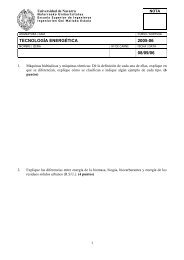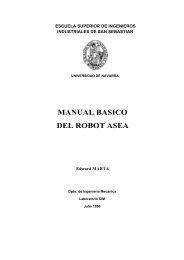Polarización usando una sola fuente de alimentación ... - Tecnun
Polarización usando una sola fuente de alimentación ... - Tecnun
Polarización usando una sola fuente de alimentación ... - Tecnun
You also want an ePaper? Increase the reach of your titles
YUMPU automatically turns print PDFs into web optimized ePapers that Google loves.
FUENTES DE CORRIENTE Y CARGAS ACTIVAS<strong>Polarización</strong> <strong>usando</strong> <strong>una</strong> <strong>sola</strong> <strong>fuente</strong> <strong>de</strong> <strong>alimentación</strong>v DDR ER 1R CV BB =V DDR 2R 1 +R 2v DDR 2BCER B =R 1 ||R 2I CBI BR CCEI ER EtecnunV BB =V DDR 2R 1 +R 2R B = R 2 R 1R 1 +R 2V BB -V BEI E =R E +R B /(β+1)Para que I Esea insensible avariaciones en temperatura y β:V BB >>V BER E >>R B /(β+1)FUENTES DE CORRIENTE Y CARGAS ACTIVAS<strong>Polarización</strong> <strong>usando</strong> <strong>una</strong> <strong>sola</strong> <strong>fuente</strong> <strong>de</strong> <strong>alimentación</strong>v DDv DDR CR CI C +I B =I ER BBCR BI BBCI CV C =V BE +I B R BEV BEI EEtecnunV DD =I E R C +(I E /(β+1))R B +V BEV DD -V BEI E =R C +R B /(β+1)Para que I Esea insensible avariaciones en temperatura y β:R C >>R B /(β+1)
FUENTES DE CORRIENTE Y CARGAS ACTIVAS<strong>Polarización</strong> con dos <strong>fuente</strong>s <strong>de</strong> <strong>alimentación</strong>v DDv DDR CR B-v EER E +R B /(β+1)R BR CBCBCEI BER EI ER E-v EEI E =V EE -V BEtecnunFUENTES DE CORRIENTE Y CARGAS ACTIVAS<strong>Polarización</strong>R G1R G2v DDR DG DSR S<strong>Polarización</strong> <strong>usando</strong> <strong>una</strong><strong>sola</strong> <strong>fuente</strong> <strong>de</strong> <strong>alimentación</strong><strong>Polarización</strong> con dos<strong>fuente</strong>s <strong>de</strong> <strong>alimentación</strong>R Dv DDR GG DR DR G-v SSGDSR Sv DDS<strong>Polarización</strong> <strong>usando</strong> <strong>una</strong><strong>sola</strong> <strong>fuente</strong> <strong>de</strong> <strong>alimentación</strong>tecnun
FUENTES DE CORRIENTE Y CARGAS ACTIVAS<strong>Polarización</strong> con <strong>fuente</strong> <strong>de</strong> corrientev DDR CRs+ -v sBCEI-v DDC ER Dv od+ -M 1v DDR DM 2+ -+ - v id2R TAILv id2tecnun-v DDFuentes <strong>de</strong> corrienteAmpliamente utilizadas en la polarización <strong>de</strong> circuitos integrados (CI) por lamenor área ocupada y menores dispersiones frente a variaciones <strong>de</strong> proceso.FUENTES DE CORRIENTE Y CARGAS ACTIVASEspejo <strong>de</strong> corrienteV BE2 =V T ln I C2I S2I IREFC2 =I O=V BE1 =V T ln I C1I S1I S2II C1S1Q 1 Q 2I REF -I C1 - I C1β- I C2tecnun-v DDI O =I C2 =I S2II C1S1Si Q 1 = Q 2 entonces:β = 0= I 1S2II REFS1 1+(IS2 /I S1 )1+βI O =I REF11+2/β
tecnunComo implementar I REFRI REFI OV OQ 1 Q 2I REF = V DD -V BERFUENTES DE CORRIENTE Y CARGAS ACTIVASEspejo <strong>de</strong> corrienteSi se consi<strong>de</strong>ra el efecto Early:I O ~I REF11+2/βR O = V AI C2I O-V AV CE2(sat)1+ V CE2 -V BEV AEfecto EarlyV OFUENTES DE CORRIENTE Y CARGAS ACTIVASEspejo <strong>de</strong> corrienteI REFQ 2I C1I B2I E2Q 1Q 3I OI E2 = -IB2 = -I C1β - I C3β = - 2 βI E21+β = 2β(1+β)2I REF - I C1 -β(1+β)I C1= 0I C1I C1Al ser Q 1 y Q 3 idénticos se tiene:tecnun1I O =I C3 = I REF21+β(1+β)
FUENTES DE CORRIENTE Y CARGAS ACTIVASEspejo <strong>de</strong> corrienteV GS2 =V t +2I D2k(W/L) 2= V GS1 = V t +2I D1k(W/L) 1I REFI OAl ser I O =I D2 entonces:M 1 M 2(W/L) 2I O =I D1(W/L) 1La resistencia <strong>de</strong> salida será:R O =r o2 = V AI D2= 1λI D2tecnunFUENTES DE CORRIENTE Y CARGAS ACTIVASEspejo <strong>de</strong> corrienteSi se consi<strong>de</strong>ra el efecto Early y V A >>V DS1 :RI REFM 1 M 2I OComo implementar I REFV O(W/L) 2V DS2I O ~I REF1+(W/L) 1 V A2IV OUT(min) = D2k(W/L) 2I OV OEfecto EarlytecnunI REF = V DD -V GSRV OUT(min)
FUENTES DE CORRIENTE Y CARGAS ACTIVASComparación entre espejos <strong>de</strong> corriente Bipolares y MOStecnun• El espejo <strong>de</strong> corriente MOS no es alterado por el efecto <strong>de</strong> β finita.• En el espejo <strong>de</strong> corriente Bipolar, el voltaje mínimo <strong>de</strong> salida esV CEsat , que es aprox. 0.2V. El correspondiente valor en circuitos MOSes (V GS -V t ) que suele ser mayor que V CEsat . Esta capacidad <strong>de</strong> trabajarcon voltajes <strong>de</strong> salida pequeños es importante en el diseñocontemporáneo <strong>de</strong> circuitos integrados, don<strong>de</strong> los voltajes <strong>de</strong> la <strong>fuente</strong><strong>de</strong> <strong>alimentación</strong> se reducen constantemente.• La razón <strong>de</strong> transferencia <strong>de</strong> corriente en un espejo bipolar está<strong>de</strong>terminada por las áreas <strong>de</strong> emisor relativas <strong>de</strong> los transistores,mientras que en un espejo MOS está <strong>de</strong>terminada por las razonesrelativas (W/L).• Tanto los espejos básicos bipolares como los MOS tienen <strong>una</strong>resistencia <strong>de</strong> salida <strong>de</strong> r O =|V A |/I, pero |V A | suele ser menor paradispositivos MOS.FUENTES DE CORRIENTE Y CARGAS ACTIVASEjercicioI REFQ 2Q 1Q 3I O1Q 4I O2R 1R 3 R 4I O1 , I O2 y V Omin ?tecnun
FUENTES DE CORRIENTE Y CARGAS ACTIVASEjercicioEspejo <strong>de</strong> corrienteWilsonI OI REFQ 2V OQ 1Q 3I O1 y V Omin ?tecnun


